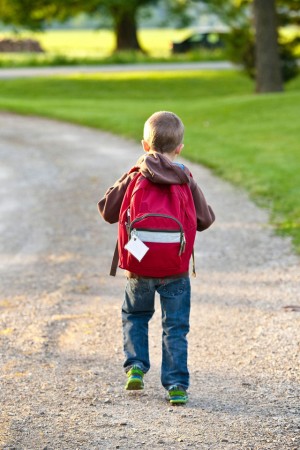 Now that another school year is well underway, thousands of children are walking to school each day across Canada. University of Guelph researcher Barbara Morrongiello is working to help keep them safe.
Now that another school year is well underway, thousands of children are walking to school each day across Canada. University of Guelph researcher Barbara Morrongiello is working to help keep them safe.
Drivers need to pay extra attention to children crossing the street because they’re still learning how to evaluate traffic, says Morrongiello, a psychology professor and director of the Child Development Research Unit at U of G. Her lab uses virtual reality technology to learn how children cross the street and to help improve their crossing skills.
Children between the ages of five and nine are at particular risk of being injured by motorists. Factors that contribute to children’s risk of injury when crossing the street include their smaller size, which makes them harder to see, and their shorter legs, which reduce their walking speed, she says.
Children’s ability to cross the street safely also depends on their age, attention skills, personality and how their parents taught them about traffic safety. “Some children are less prepared than others to make the kind of choices needed to keep themselves safe,” says Morrongiello.
Key skills for safe street crossing include being able to perceive a vehicle’s distance and speed. “Young children pay more attention to the distance of a car than the speed that it’s moving,” she says, referring to the children who have participated in her virtual reality studies. “There might be perceptual limitations related to age that make youngsters less able to cross safely.”
Because they focus on distance, children may assume that it’s safe to cross the street if an oncoming car is far away, without taking its speed into account. They may walk more slowly, thinking they have more time to cross in front of a distant vehicle. Children may also stop paying attention to traffic as they cross the street, thinking that cars are far away or that drivers will see them and stop.
Children in her study wear a virtual reality headset that depicts a neighbourhood with traffic on a street, and they are evaluated on their ability to cross the virtual street safely. “We take measures of where they were looking, how close the car came, what their walking speed was, the distance of the car versus the speed and movement of the car,” she says. “From that we calibrate how safely they walked across the street.” Morrongiello hopes her findings will help improve child pedestrian safety.
It’s not enough for parents to tell their children how to cross the street safely; they need to show them and test their abilities to do so, she adds. Children often model their parents’ behaviour, so it’s important for parents to set a good example when crossing the street, such as using crosswalk signals and looking both ways before crossing. “It leads to greater risk-taking in children if their parents weren’t modelling safe practices,” says Morrongiello.
Parents also tend to overestimate their children’s ability to cross the street safely, she adds. “That’s a problem because parents are assuming kids are more competent than they are.” Parents may stop supervising their children too soon and allow them to walk to school on their own before they’re ready to do so safely.
Morrongiello advises parents to evaluate their children by their street-crossing skills, not their age, before allowing them to walk to school alone. Parents can start by walking a few steps behind their children to give them a sense of independence while evaluating their ability to look both ways, judge speed and distance of vehicles, and adjust their walking speed according to traffic when crossing.
Drivers also need to be alert.
“I caution drivers to be on the lookout for young children on the sidewalk and to assume that they’re going to be impulsive and do crazy things, like run into the street” says Morrongiello. “Be prepared to always stop.”